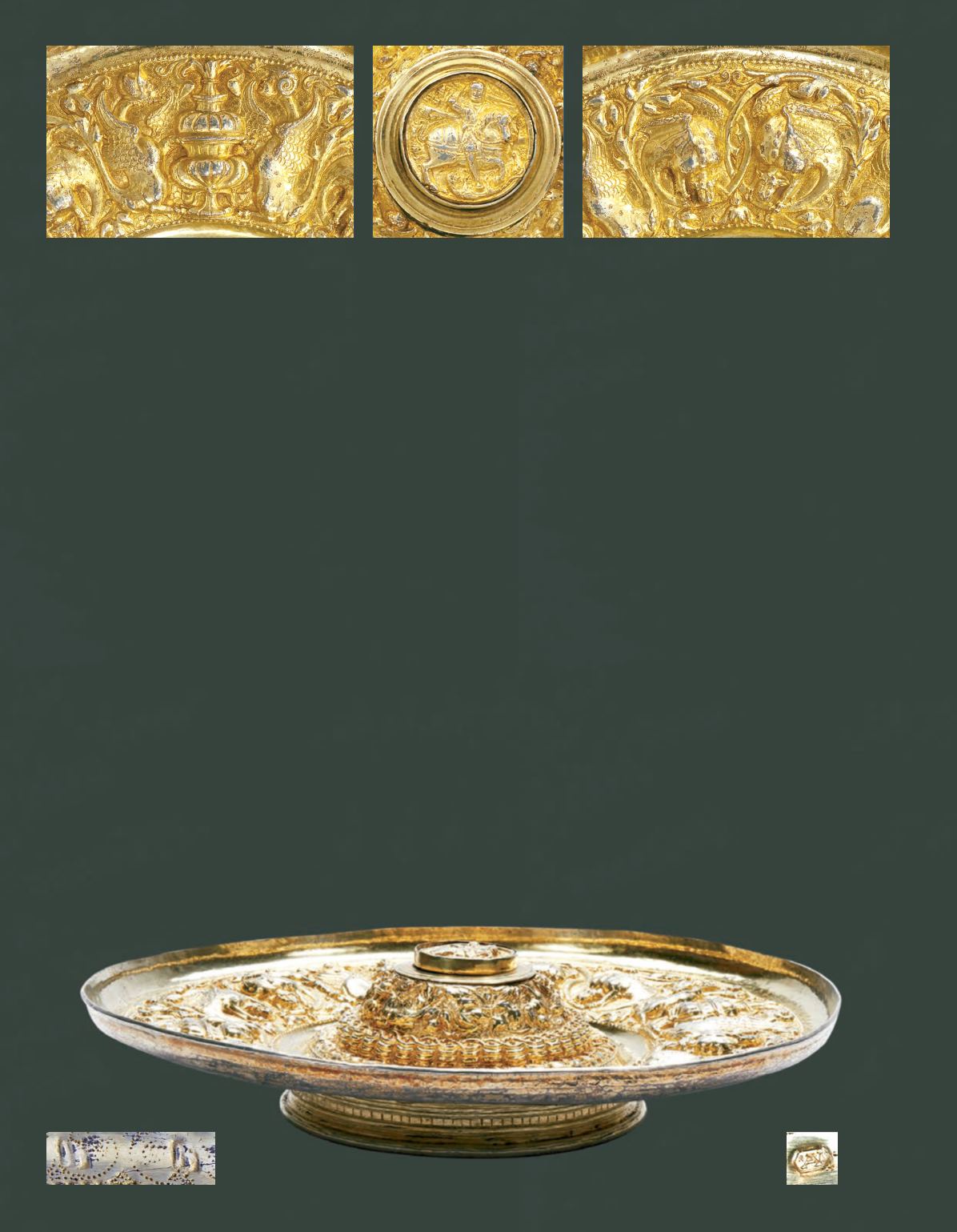
274
cabral moncada leilões 186 | 14 de Março de 2017
Esta elegante salva, com o seu pé baixo original, é um belo exemplo da
introdução da linguagem do renascimento na ourivesaria civil portuguesa,
nos inícios do século XVI, produção descrita na documentação como
“ao Romano”. Segue o esquema das salvas góticas, com os motivos
ornamentais distribuídos ininterruptamente na aba e em torno do medalhão
central elevado, este representando São Jorge e o Dragão. De acordo com
o perito Henrique Correia Braga, embora adaptado posteriormente,
o medalhão é obra da época da salva, ou até um pouco mais recuado,
eventualmente alemão. Todos os ornatos são inspirados em “grotescos”,
neste caso com criaturas fantásticas ladeando simetricamente ânforas
clássicas que se desenvolvem por enrolamentos concluindo em animais
fantásticos afrontados. Os motivos dos “grotescos” difundem-se com grande
expressão na Arte Portuguesa da época, de que a ornamentação do claustro
do Mosteiro dos Jerónimos é um verdadeiro catálogo. O gosto pelo detalhe,
ainda de tradição gótica, revela-se no complexo trabalho de reprodução
de uma cerca de cordame enrolado, que circunscreve o centro da salva.
Este é ornamentado com criaturas fantásticas que aparentemente
não a podem transpor. Embora seguindo motivos clássicos, denuncia como
a oficina onde foi executada não se encontrava completamente familiarizada
com a precisão do desenho dos novos motivos renascença a que recorreu,
numa procura de satisfazer o desejo de novidade das clientelas,
dado que quase se confundem com o bestiário medieval.
A Cabral Moncada Leilões regista e agradece ao Doutor Nuno Vassalo e Silva
e ao perito Henrique Correia Braga o seu contributo para a descrição
e enquadramento histórico-artístico desta salva.
This elegant salver, with its original low stem, is a fine example
of the introduction of Renaissance language in Portuguese civil silver
at the beginning of the 16th century, described in the documentation
as “the Roman manner”. It follows the scheme of Gothic salvers with
the ornaments distributed uninterruptedly on the rim and around
the elevated central medallion, the last one representing St. George
and the Dragon. According to Expert Henrique Correia Braga, though later
adapted to the salver, the central medallion is from the same time of the
salver, or even earlier, possibly German. All the embellishments are inspired
in the “grotesque”, in this case with fantastic beasts flanking symmetrical
classical amphorae which develop by windings, ending in fantastic beasts
facing each other. “Grotesque” motifs are diffused with full expression
in the Portuguese art of the time, of which the embellishment of the cloister
of the Jerónimos Monastery is a true catalogue. The taste for detail,
still of Gothic tradition, can be seen in the complex work of reproduction
of a fence of coiled rope which encloses the centre of the salver.
This is embellished with fantastic creatures who apparently cannot
transpose it. Although following classical motifs, it denounces the fact
that the workshop where it was executed was not interely familiar with
the precision of the design of the new Renaissance motifs used, in a demand
to satisfy the desire for novelty of the clientelles, given the fact they almost
get confused with medieval bestiary.
Cabral Moncada Auctioneers wishes to express his recognition and to thank
Doutor Nuno Vassallo e Silva and Expert Henrique Correia Braga for their
contribution to the description and historical-artistic framework of this salver.
Bibliografia/References: vd. ALMEIDA, Fernando Moitinho de - “Marcas de Pratas Portuguesas e Brasileiras (Século XV a 1887)”.
Lisboa: IN-CM, 1995, P313B; e SILVA, Nuno Vassalo e - “Ourivesaria Portuguesa de Aparato. Séculos XV e XVI”. Lisboa: SCRIBE, 2012.


